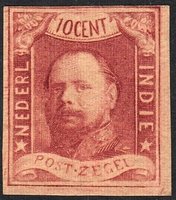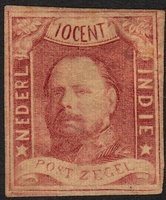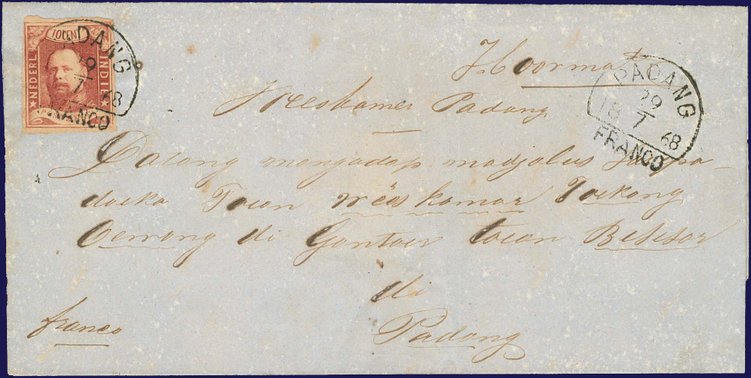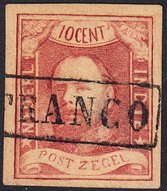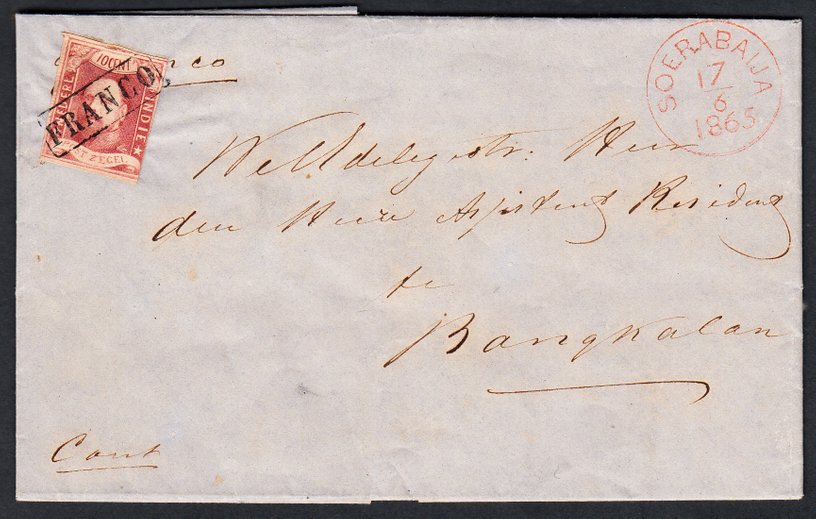10 cent 1864
The first stamp of the Netherlands East Indies is the red 10 cent imperforated stamp with a portrait of King Willem III (1817-90; king 1849-90). The stamp was designed and engraved by J. W. Kaiser in Amsterdam and printed by the Royal Dutch Mint in Utrecht. It was printed on thick yellowish paper without watermark in sheets of 100 stamps: in all 20.000 sheets were printed, making a total of 2.000.000 stamps. (In comparison, the famous Penny Black, the first stamp of Great Britain of 1840, was printed in about 68.000.000 copies.) The date of issue was April 1st 1864.
Letter sent from the sub-post office of Solok in West Sumatra to the children's orphanage in nearby Padang. On the back is the rare longcancel of Solok in red. The stamp was cancelled on arrival in Padang 29 July 1868. The distance from Solok to the provincial capital Padang is only 36 km, but the letter had to travel around tall mountains and volcanoes via Padang-Pandjang in the cool highlands north of Padang, a route of about 160 km. Click here for an image of the back.
Some unusual cancellations on the 1864 issue
A half-round cancel of Djokjokarta in combination with a numeral cancel 37 of the Dutch type (this is not the 37 of Serang). Probably this is the 37 of Franeker or the 137 of the Arnhem-Oldenzaal railway line (in use from 1/4 1869).
Part of a half-round cancel (Magelang/Makas-
sar/Madioen) and an octagonal cancel probably of Penang or the Straits Settlements.
the black franco-in-box together with a peculiar looking franco cancel (perhaps a private manufacture?).
Siboga long cancels in blue and in red with the Padang half-round franco of 15/3 1868.
Rau long cancel (one of two known)
With part of Singapore datestamp of May 1868 (the only known on this issue)
a Dutch district cancel 67(?) in circle with parts of Dutch Indies franco
a triple cancellation: handwritten franco, black franco-in-box, and the 'na posttijd cancel for late submission
A Chinese-style envelope from Madioen 2 March 1865 sent to Samarang. This is a conventional usage of the black franco cancel and date cancel in red. On the back is the Samarang receiver of 4 March.
The framed franco cancel
This is the most common cancel on the 1864 issue, in use from the release of the stamps in April 1864 till around May 1866. It continued to be used by the sub-post offices after mid-1866.
FRANCO in blue (rare)
FRANCO in black
A wrapper from Passoeroean in East Java postmarked June 20 1865 to the local colonial governor ('assistant resident') of Modjokerto. As is most often the case the stamp was placed in the top left corner. Handwritten 'franco' and the franco-in-box cancel the stamp, and the date cancel is a red cancel of the 'rondstempel' type. An entirely conventional usage.
Piece with framed FRANCO and datecancel Djokjacarta
29 Aug 1864
A large part of a Chinese letter with a double cancellation of handwritten 'franco' and the black franco-in-box. The red date cancel of Tegal shows an early usage of 22 June 1864.
